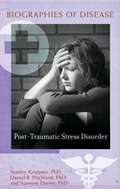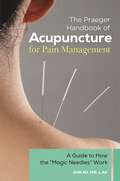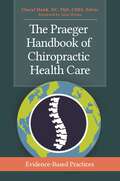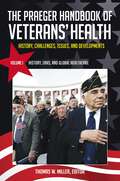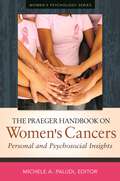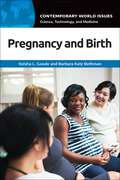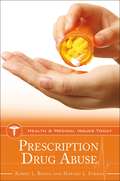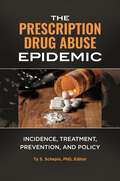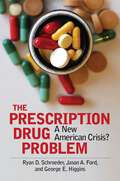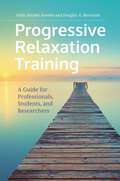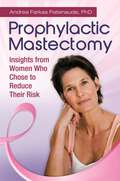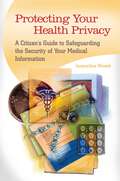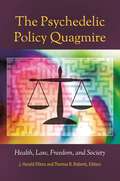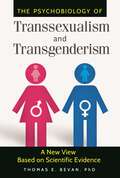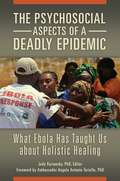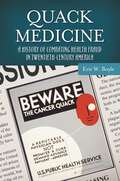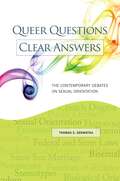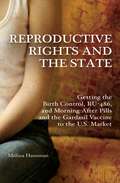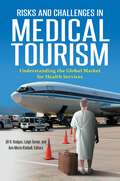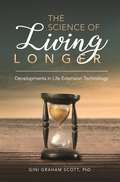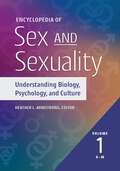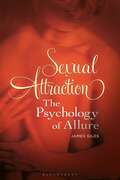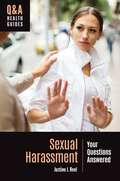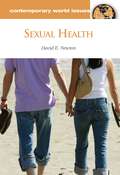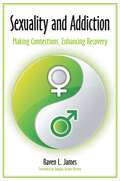- Table View
- List View
Post-Traumatic Stress Disorder (Biographies of Disease)
by Stanley Krippner Daniel B. Ph.D. Jeannine A. Ph.D.Three distinguished experts share cutting-edge insights on Post-Traumatic Stress Disorder (PTSD), showing why it occurs, how it affects the development and existence of those it impacts, and how it can be treated.Post-Traumatic Stress Disorder is a comprehensive and thoughtful examination of the nature, causes, and treatment of PTSD. Drawing on the vast experience of its team of authors, the book details the insidious nature and history of PTSD, from the internal and external factors that cause this form of suffering to the ways it manifests itself psychologically and socially. The most cutting-edge research on treatment, intervention, and prevention is thoroughly discussed, as are the spiritual and psychological strengths that can emerge when one progresses beyond the label of "disorder."The book begins with a historical review of the topic. Subsequent chapters offer in-depth exploration of the significant foundations, function, impacts, and treatments associated with PTSD. Each chapter addresses practical issues, incorporating case studies that bring the information to life and ensure an appreciation of the myriad social, psychological, and biological experiences surrounding PTSD. This book answers complex questions like "How does PTSD manifest itself?" and more critically: "How can its effects be mitigated or overcome?" Finally, it discusses how PTSD survivors can move beyond post-traumatic stress to post-traumatic strengths.
The Praeger Handbook of Acupuncture for Pain Management: A Guide to How the "Magic Needles" Work
by Jun Xu L.AcThis unique text examines 30 specific pain management case studies to explain pain treatments from the perspectives of Eastern acupuncture and traditional Chinese medicine as well as that of Western medical practice.Millions of Americans are affected or incapacitated by a wide variety of chronic pain—from heel spurs, herniated discs, and hip bursitis to osteoarthritis, plantar fasciitis, and rotator cuff tears. As complex as the injuries and problems can be, medically speaking, for many pain sufferers, the question is simple: can acupuncture work to make my pain go away? This book provides information from 30 different pain management cases to shed light on the effectiveness of acupuncture treatments in specific situations.Presented in easy-to-understand, plain language, the author explains why acupuncture works to stop pain from the theoretical frameworks of both traditional Chinese medicine and Western medicine. Each chapter describes the potential sources and systems of specific pain, depicts the acupuncture points for that pain, and explains how they work. The case studies—selected from more than 9,000 patients seen by Dr. Xu during his 14 years of clinical practice in the United States—document how acupuncture has effectively granted these individuals relief from pain, whether viewed from the Western science of neurology, or the Eastern theories of yin and yang and keeping the body's energies in a balanced state.
The Praeger Handbook of Chiropractic Health Care: Evidence-Based Practices
by Cheryl HawkWhat does scientific research show about the effectiveness of chiropractic care? How are chiropractors trained and what do they do? When should one turn to chiropractic care, and how does one select a practitioner? This book answers all of these questions and more.Chiropractic is the most frequently used complementary and alternative medicine (CAM) practice in the United States, with nearly $4 billion spent out-of-pocket annually by chiropractic patients. In fact, as evidence for its effectiveness for common conditions such as back pain continues to mount and acceptance grows in a variety of health care settings, chiropractic could be considered more "mainstream" than many other forms of CAM. In this information-packed single-volume work, an expert team led by Cheryl Hawk—a well-known chiropractic researcher—explains chiropractic licensure, practice, and effectiveness to general readers researching chiropractic care options and to undergraduate students choosing a major or specialty. Readers will see the range of scientific evidence supporting the use of chiropractic health care for many common conditions, learn about the typical chiropractic clinical encounter and chiropractic procedures, and understand the criteria by which patients and other health professionals can use to select a chiropractic physician. This book also provides health care practitioners in other fields with current information that enables a greater understanding of the training and the roles of chiropractors in health care.
The Praeger Handbook of Veterans' Health [4 volumes]: History, Challenges, Issues, and Developments [4 volumes]
by Thomas W. MillerThis four-volume set provides a history of veterans' healthcare that examines programs of care and veterans' special needs, and offers insight into future directions for veteran's healthcare in the 21st century.This comprehensive contribution to understanding veterans' healthcare uniquely draws on a national and international cadre of scientists and practitioners, both within the Department of Veterans Affairs and specialists beyond the institution, providing a matrix view of veterans' healthcare, past, present, and future, both nationally and internationally. This work will prove an essential reference set that examines and identifies veterans' healthcare through the first decade of the 21st century, invaluable to health and psychology researchers and students, policymakers, social workers, and veterans.The Praeger Handbook of Veterans' Health: History, Challenges, Issues, and Developments is organized to cover four key elements. Volume I presents a history of veterans' healthcare, the various veteran's eras, and the global healthcare provided to our veterans. Volume II examines several of the programs of care and veterans' special needs. Volume III is devoted to the several aspects of mental health care, treatment, and rehabilitation services offered to veterans through the healthcare system. The last volume offers insights into future directions for veterans' healthcare.
The Praeger Handbook on Women's Cancers: Personal and Psychosocial Insights (Women's Psychology)
by Michele A. PaludiWritten by experts in psycho-oncology, this book synthesizes the findings of the latest research on women's cancers to empower women to make informed choices about treatment options.Each year, hundreds of thousands of women are diagnosed with cancer in the United States alone. The total number affected is larger still, comprising siblings, parents, partners, and children of these women. In this single-volume work, an international team of experts address the physical, medical, and psychological matters that are triggered by a diagnosis of having a form of "women's cancer"—breast, cervical, endometrial, gestational, ovarian, uterine, vaginal, and vulvar being some of the more common. The handbook examines and explains each type of women's cancer, covering the specifics of incidence, diagnosis, treatment options, and more, providing an up-to-date guide for women and their families to assist in making informed choices about their treatment options. The book includes personal accounts from women who survived cancers and beat their emotional challenges, addresses myths versus realities regarding women's cancers, and covers relevant, related topics such as race, sexual orientation, religion, and cancer coping. Special attention is given to the impact of women's cancers on relationships, intimacy, and body image, as well as psychological factors such as anxiety, depression, and fear.
Pregnancy and Birth: A Reference Handbook (Contemporary World Issues)
by Keisha L. Goode Barbara Katz RothmanPregnancy and Birth: A Reference Handbook provides students with information too often ignored in sex education—on what pregnancy and birth are, have been, and can be as transformative personal and social events.Pregnancy and Birth: A Reference Handbook is a person-centered reference book on pregnancy and childbirth in the United States. The medicalization of pregnancy and childbirth is a theme; however, primary emphasis is on the historical and contemporary significance of the Midwifery Model of Care and how that can improve outcomes for all.The volume opens with a background and history of the topic, followed by a chapter on related problems, controversies, and solutions. A Perspectives chapter contains essays from a variety of individuals who are invested in the topic of pregnancy and birth. The remaining chapters provide students with additional information, such as profiles, data and documents, resources, a chronology, and a glossary. This book is accessible to high school and college-level researchers, as well as general-interest readers curious about the topic.
Prescription Drug Abuse (Health and Medical Issues Today)
by Robert L. Bryant Howard L. MDThe misuse and abuse of prescription drugs has reached epidemic proportions in recent years, yet many individuals still believe, incorrectly, that their use is without risk. This book explores those risks as well as controversies surrounding this public health issue.Prescription drugs are powerful tools that can be used to treat a variety of ailments, from pain to anxiety to insomnia. Their potency and perceived safety also make them targets for abuse. The misuse of prescription drugs can have dire health consequences for individuals and high economic costs for society, among other dangers. A part of Greenwood's Health and Medical Issues Today series, this book identifies prescription drugs that are abused and the consequences such abuse can have for both individuals and society, and discusses the many questions relating to how to address this public health issue. Part I explores the current magnitude of the prescription drug abuse epidemic in the United States, which drugs are most frequently abused, how individuals obtain these medications, and the consequences of abuse. Part II delves into the controversies surrounding the topic, including the roles that doctors and "Big Pharma" play and legal issues regarding prosecution of prescription drug abusers. Part III provides a variety of useful materials, including case studies, a timeline of critical events, and a directory of resources.
The Prescription Drug Abuse Epidemic: Incidence, Treatment, Prevention, and Policy
by Ty S. SchepisThis overview of prescription drug abuse includes historical background, key concepts, and discussion of the prevalence of drug abuse, treatments, and policy issues implicated in ending the epidemic.Prescription opioid medication abuse has been declared a national crisis by experts in medicine, substance use, public health, and pain management, culminating in a declaration made by the President of the United States that opioid misuse and abuse is a national health emergency. In this comprehensive text, expert scholars analyze and address a wide range of issues in, obstacles to, and potential solutions for this emergency, which caused more than 50,000 deaths in 2016 alone. It covers a variety of topics related to prescription misuse from both clinical and academic perspectives. After an opening containing background material on the most commonly misused medications, chapters examine subgroups engaged in misuse and special medical environments where misuse issues are key. They then cover U.S. policy, perspectives outside the U.S., and theories that may explain the misuse phenomena. This book will serve as a resource for students and professionals in fields related to prescription drug abuse—including psychology, sociology, medicine, and public policy—and is accessible to individuals not trained in these fields.
The Prescription Drug Problem: A New American Crisis?
by Ryan D. Schroeder Jason A. Ford George E. HigginsProviding an indispensable resource for undergraduate students, graduate students, and policymakers interested in the prescription drug abuse crisis in the United States, this book summarizes the current state of prescription drug abuse and its growth over the past 20 years.The Prescription Drug Problem analyzes the growth of the prescription drug abuse problem from 1994 to 2014 and includes comparisons to marijuana and hard drug use during the same period. Specific attention is given to prescription opiate abuse and the transition from prescription opiates to heroin. The book begins with a broad overview of the prescription drug problem in the U.S., while the text presents stories of celebrities who have struggled with prescription drug abuse, highlights a handful of ordinary Americans who are battling prescription drug abuse, and examines as case studies a few communities that have been ravaged by prescription drug abuse. Drawing upon demographic patterns of abuse to identify causes of and factors contributing to prescription drug abuse as well as possible solutions to the problem, the book is designed to provide a broad overview of the prescription drug abuse problem in the U.S. and stimulate additional research.
Progressive Relaxation Training: A Guide for Professionals, Students, and Researchers
by Holly Hazlett-Stevens Douglas A. BernsteinOffers comprehensive guidance for practitioners, students, and researchers in psychology, psychiatry, and counseling to teach relaxation to clients.Two clinical psychologists widely known for their writings on relaxation present state-of-the-art methods for teaching clients to ease muscle and mind tension to deal with stress and anxiety disorders, as well as other conditions where stress and anxiety play a role. Bernstein and Hazlett-Stevens explain who the targets for Progressive Relaxation Training (PRT) are; the rationale, basic procedures, and variations of PRT; the setting and possible problems and solutions of PRT; and how to assess a client's progress. They also address hypnosis, drugs, and PRT, as well as PRT used in a mindfulness-based clinical practice. Case studies and evaluative research in PRT are also included. Students and practitioners in psychology, psychiatry, and counseling will find this work of interest. This book may also be useful supplemental reading for behavior modification courses and practicum courses in behavior therapy.
Prophylactic Mastectomy: Insights from Women Who Chose to Reduce Their Risk
by Andrea PatenaudeThis book presents the candid stories of women at high hereditary risk of breast cancer who chose to have their breasts surgically removed while they were still healthy, rather than risk getting the cancer that had, in many cases, devastated others in their family.Author Andrea Farkas Patenaude, a clinical psychologist at the Dana-Farber Cancer Institute, has spent much time talking with women who decided to have risk-reducing or prophylactic mastectomy rather than undergo a lifetime of repeated screenings—a strategy that can help to detect cancers early, but cannot prevent breast cancer. In Prophylactic Mastectomy: Insights from Women Who Chose to Reduce Their Risk, Patenaude shares many candid stories from these women and documents the risks and benefits of this decision.The potential emotional trauma and lifelong effects on self-concept, body image, and sexual function for those who choose the surgery are profound. While the risks involved are great, these interviews also demonstrate the relief many women find in making this powerful decision. This book supplies much-needed guidance for both patients and physicians in confronting this complex decision, and provides comprehensive information on how women fare emotionally and interpersonally after this life-altering surgery.Interviewed as part of a study funded by the Department of Defense Breast Cancer Research Program and the National Human Genome Research Institute, the subjects are diverse: married and single women, young adults, the middle-aged, parents, and women without children. Every case reveals the ramifications of each individual's difficult but potentially life-saving decision. The women explain why they made their choice, how they adapted to the new look of their bodies, and how they cope with spouses', partners', and family members' reactions to their changed physique.
Protecting Your Health Privacy: A Citizen's Guide to Safeguarding the Security of Your Medical Information
by Jacqueline KlosekProtecting Your Health Privacy empowers ordinary citizens with the legal and technological knowledge and know-how we need to protect ourselves and our families from prying corporate eyes, medical identity theft, ruinous revelations of socially stigmatizing diseases, and illegal punitive practices by insurers and employers.It's a new era in healthcare. Gone are the day when access to your medical records is limited to you and your doctor. Instead, today, a diverse group of constituencies have interest in and access to your health information. A cascade of changes in technology and the delivery of healthcare are increasing the vulnerability of your medical information. Accordingly, it is now more important than ever to take control over your own health information and take steps to protect your information against privacy breaches that can adversely impact the quality of your health care, your insurability, your employability, your relationships, and your reputation. In clear, non-technical language, privacy lawyer Jacqueline Klosek teaches readers the basics you need to know as an individual healthcare consumer about the ongoing wave of national and state legislation affecting patient privacy: the Patient Protection and Affordable Care Act (PPACA) of 2010, the Health Information Technology for Economic and Clinical Health Act (HITECH) of 2009, and the Health Insurance Portability and Accountability Act (HIPAA) of 1996. She untangles the increasingly complex ways by which health care providers, insurers, employers, social networking sites, and marketers routinely collect, use, and share our personal health information. Protecting Your Health Privacy: A Citizen's Guide to Safeguarding the Security of Your Medical Information empowers ordinary citizens with the knowledge and know-how we need to protect ourselves and our families from prying eyes, medical identity theft, ruinous revelations of socially stigmatizing diseases, and illegal punitive practices by insurers and employers.
The Psychedelic Policy Quagmire: Health, Law, Freedom, and Society (Psychology, Religion, and Spirituality)
by J. Harold Ellens Thomas B. RobertsEdited by two preeminent scholars, this book provides coverage of the policy issues related to the increasingly diverse treatments, practices, and applications of psychedelics.Hallucinogenic substances like LSD, mescaline, peyote, MDMA, and ayahuasca have a reputation as harmful substances that are enjoyed only by recreational users committing criminal acts. But leading international researchers and scholars who contributed to this book hold that the use of psychedelic substances for health, religious, intellectual, and artistic purposes is a Constitutional right—and a human right. Based on that conclusion, these scholars focus on policy issues that regulate the use of psychedelic drugs in medicine, religion, personal life, and higher education, arguing that existing regulations should match current and anticipated future uses.This volume has two parts. The first surveys research on the use of psychedelic drugs in medicine, religion, and truth-seeking, following these topics through history and contemporary practice. The second section treats government policices that regulate the psychological, physiological, biochemical, and spiritual aspects of research and experience in these fields. The Psychedelic Policy Quagmire: Health, Law, Freedom, and Society challenges medical and legal policy experts, ethicists, scientists, and scholars with the question: How can we formulate policies that reduce the dangers of psychedelics' misuse and at the same time maximize the emerging diverse benefits?
The Psychobiology of Transsexualism and Transgenderism: A New View Based on Scientific Evidence
by Dana Jennett Ph.D.Written by a biopsychologist, this book describes and explains transsexualism and transgenderism (TSTG) from a scientific vantage point.Why does a male violate cultural gender rules and dress and act as a woman? Why does a female violate cultural rules to dress and act as a man? Why do some males and females undergo radical medical procedures in order to permanently change their bodies so that they are closer, respectively, to female and male bodies? In this book, a Princeton University-trained physiological psychologist explores dozens of theories about what may spur transsexual and transgender (TSTG) thinking, exposes the myths of fetishism, homosexuality, prenatal hormones, or child rearing as causes, and explains the two causes that are supported by current science.Covering a breadth of topics that include neuroanatomy, choice, psychodynamics, and transsexual transition, author Thomas E. Bevan, PhD, synthesizes the pertinent research regarding transsexualism and transgenderism across 22 scientific disciplines. The book covers various gender systems from antiquity to historical and contemporary cultures that support the biological basis of transsexualism and transgenderism, addresses human development from the time prior to conception through adulthood and potential transsexual transition, and corrects common myths and assumptions about TSTG individuals, such as that crossdressing is basically motivated by a desire for sexual arousal. The book also includes sections that cite definitions of key terms and identify related reading, organizations for support, and current TSTG events worldwide.
The Psychosocial Aspects of a Deadly Epidemic: What Ebola Has Taught Us about Holistic Healing (Practical and Applied Psychology)
by Judy KurianskyEdited by a clinical psychologist who has been on the ground helping to develop psychosocial support for Ebola survivors in one of the hardest-hit regions of West Africa, this book explains the devastating emotional aspects of the epidemic and its impact on survivors and the population in West Africa, families in the diaspora, and people in the United States and other countries. It also describes lessons learned from past epidemics like HIV/AIDS and SARS, and valuable approaches to healing from future epidemics.While the devastating Ebola epidemic has been contained, the effects of this outbreak—referred to by the World Health Organization as "the most severe acute public health emergency seen in modern times"—have wreaked a tremendous emotional toll on the populations of West Africa as well as on families and survivors worldwide. This groundbreaking book covers the psychosocial needs, programs, and policies related to the Ebola epidemic and examines broader lessons of the outbreak, such as changes in the ways in which healing from future epidemics can be handled.Edited by Judy Kuriansky, PhD, a noted clinical psychologist and United Nations NGO representative with extensive experience helping after disasters worldwide, and direct experience gained from being "on the ground" in West Africa in the midst of the epidemic, this book identifies and explains universal psychological factors at play in all such crises. It debunks myths regarding Ebola and describes the resulting psychological and social harm caused by the epidemic. The chapters cover overarching emotional issues and problems as well as the long-term impact on at-risk groups, such as children, women, and health workers; the impact of emotional issues on social and economic life; responses of government officials, media, and various aid organizations; and solutions being offered by groups worldwide, including service and humanitarian organizations, politicians, policymakers, and public health education groups.
Quack Medicine: A History of Combating Health Fraud in Twentieth-Century America (Healing Society: Disease, Medicine, and History)
by Eric W. BoyleThis timely volume illustrates how and why the fight against quackery in modern America has largely failed, laying the blame on an unlikely confluence of scientific advances, regulatory reforms, changes in the medical profession, and the politics of consumption.Throughout the 20th century, anti-quackery crusaders investigated, exposed, and attempted to regulate allegedly fraudulent therapeutic approaches to health and healing under the banner of consumer protection and a commitment to medical science. Quack Medicine: A History of Combating Health Fraud in Twentieth-Century America reveals how efforts to establish an exact border between quackery and legitimate therapeutic practices and medications have largely failed, and details the reasons for this failure.Digging beneath the surface, the book uncovers the history of allegedly fraudulent therapies including pain medications, obesity and asthma cures, gastrointestinal remedies, virility treatments, and panaceas for diseases such as arthritis, asthma, diabetes, and HIV/AIDS. It shows how efforts to combat alleged medical quackery have been connected to broader debates among medical professionals, scientists, legislators, businesses, and consumers, and it exposes the competing professional, economic, and political priorities that have encouraged the drawing of arbitrary, vaguely defined boundaries between good medicine and "quack medicine."
Queer Questions, Clear Answers: The Contemporary Debates on Sexual Orientation
by Thomas S. SerwatkaThis provocative book examines the important issues in contemporary debates on sexual orientation—from our various religious beliefs to our stereotypes about homosexuals, from questions about the origin of sexual orientation to the lessons we can learn from history.Queer Questions, Clear Answers: The Contemporary Debates on Sexual Orientation offers an eye-opening conversation about questions, facts—and fears—relative to sexual orientation. The book is framed around a series of nine sets of "queer questions," including, Who is queer and who is not? How do we interpret and use sacred scriptures to control behavior and set public policy? What lessons can we learn from history and psychology? and What is the homosexual agenda? The author, himself a gay man and prominent academic, combines cross-disciplinary research and personal anecdotes in his intriguing search for answers to questions that are central to ongoing cultural and political debates. In discussing each set of questions, he examines perspectives and arguments from across the political spectrum. The clear, articulate, and wholly candid answers he offers will help readers get beyond the headlines—and the sound bites—to better understand many important arguments about homosexuality and human rights.
Reproductive Rights and the State: Getting the Birth Control, RU-486, and Morning-After Pills and the Gardasil Vaccine to the U.S. Market (Reproductive Rights and Policy)
by Melissa HaussmanSimultaneously examining four significant, never-before-combined case studies, this unique feminist analysis offers troubling revelations about the private-public interaction in U.S. policy affecting birth control drugs.Reproductive Rights and the State: Getting the Birth Control, RU-486, and Morning-After Pills and the Gardasil Vaccine to the U.S. Market tackles a subject that remains controversial more than 60 years after "the pill" was approved for use in the United States. The first book to examine the politicization of the FDA approval process for reproductive drugs, this study maps the hard-fought battles over the four major drugs currently on the U.S. market.To make her case, Melissa Haussman scrutinizes the history of the FDA and the statutes that have governed it, as well as interactions between the U.S. government, American pharmaceutical companies, and the medical community. The analysis centers on explaining how three reproductive drugs were kept off the U.S. market well after their efficacy had been proven, while the availability of the fourth, Gardasil, has less to do with helping girls than with preserving the financial wellbeing of Merck. Readers will come away understanding how, when it comes to reproductive drugs, women's health concerns have consistently taken a backseat to political agendas and corporate profits.
Risks and Challenges in Medical Tourism: Understanding the Global Market for Health Services
by Jill R. Hodges, Leigh Turner and Ann Marie KimballA multidisciplinary international team examines the safety, ethics, and health implications of the emerging global market for health care, and the issues that arise when patients cross borders for medical procedures they cannot afford or access at home, from liposuction to kidney transplants.Risks and Challenges in Medical Tourism: Understanding the Global Market for Health Services provides an in-depth, comprehensive assessment of the benefits and risks when health care becomes a global commodity. The collection includes contributions from leading scholars in law and public policy, medicine and public health, bioethics, anthropology, health geography, and economics.This timely and informative handbook looks at medical tourism from the perspective of some of the major regions that send and receive medical tourists, including the United States, the European Union, Southeast Asia, and Latin America. Contributors examine how government agencies, medical tourism companies, international hospital chains, and other organizations promote medical tourism and the globalization of health care. The topics explored include the legal remedies available to medical tourists when procedures go awry; potential consequences when patients cross borders for medical procedures that are illegal in their home countries; the relationship of medical tourism to international spread of infectious disease; and the lack of adequate transnational policies and regulations governing the global market for health services.
The Science of Living Longer: Developments in Life Extension Technology
by Gini Graham Ph.DThis thought-provoking book looks at humanity's quest for immortality and examines the latest research on extending one's life and possibly living forever, presenting an overview of technological innovations such as cryonics, cell rejuvenation, organ transplants, using an exoskeleton, and brain transplants.With the seemingly limitless potential of 21st-century technology, the chance of human immortality being an actual possibility rather than a science fiction concept is tantalizingly close. And with this increased possibility of achieving immortality, a growing community of people interested in immortality has formed worldwide. Organizations dedicated to great extension of human life now exist, focusing on technologies that reverse the damage caused by aging, transfer human consciousness to an artificial body, or cryogenically freeze those who hope to be brought back to life when technology to revive the body without cellular damage is developed.The Science of Living Longer: Developments in Life Extension Technology provides a fascinating look at the current state of the scientific research on how people can live significantly longer—and possibly even forever. The book begins with an introductory section on the historical efforts to achieve immortality in Western and other cultures. Following chapters investigate different strands of research toward the common objective of achieving a longer life or even immortality. Other chapters address topics such as the health, wellness, and fitness movement designed to help individuals live longer; the biological methods—such as cell rejuvenation—designed to defeat aging; and the use of technology to provide an exoskeleton as body parts age or to download the brain into a computer or other body. Each chapter also suggests steps an individual can take to live longer, too.
Encyclopedia of Sex and Sexuality [2 volumes]: Understanding Biology, Psychology, and Culture [2 volumes]
by Heather L. ArmstrongProviding a comprehensive framework for the broad subject of human sexuality, this two-volume set offers a context of historical development, scientific discovery, and sociopolitical and sociocultural movements.The broad topic of sex—encompassing subjects as varied as sexuality, sexual and gender identity, abortion, and such crimes as sexual assault—is one of the most controversial in American society today. This two-volume encyclopedic set provides readers with more than 450 entries on the subject, offering a comprehensive overview of major sexuality issues in American and global culture.Themes that run throughout the volumes include sexual health and reproduction, sexual identity and orientation, sexual behaviors and expression, the history of sex and sexology, and sex and society. Entries cover a breadth of subjects, such as the major contributors to the field of sexology; the biological, psychological, and cultural dimensions of sex and sexuality; and how the modern-day political climate and the government play a major role in determining attitudes and beliefs about sex. Written in clear, jargon-free language, this set is ideal for students as well as general readers.
Sexual Attraction: The Psychology of Allure
by James GilesHow and why does sexual attraction happen? This book is an exploration of the universal yet highly individualized experience of being sexually attracted to another person.Incorporating interviews, research findings, and excerpts from romantic and erotic literature, lyrics, and film, Sexual Attraction: The Psychology of Allure explores a subject that is central to the human experience and highly relevant not only in personal, intimate interactions but also other relationships as well. Although the causes and effects of sexual attraction have been studied, sexual attraction itself—how we experience others in terms of their sexual attractiveness—remains a neglected, rarely researched topic.Scholar James Giles presents jargon-free information that is accessible and fascinating to the general reader as well as highly useful and informative to students and researchers in social psychology, sexology, sex and marital therapy, and relationship counseling. The book explores subjects such as how sexual attraction is fundamentally different from other forms of interpersonal attraction and how at the heart of sexual attraction lies the experience of allure—something that makes one feel helplessly drawn towards an intimate physical joining with the sexually attractive person. The allure of strangers, cross-sex friends, sexual friends ("friends with benefits"), and romantic partners are all addressed, revealing the often subtle heterosexual attraction that typically exists between males and females in all their relationships, including between those who are ostensibly "just friends."
Sexual Harassment: Your Questions Answered (Q&A Health Guides)
by Justine J. ReelThis book answers readers' most pressing questions about sexual harassment, including how to identify it, its causes, and its effects. It also provides guidance and resources for anyone experiencing or witnessing sexual harassment.Unfortunately, sexual harassment is an all-too-common reality for many women and men. But what exactly constitutes sexual harassment, and how is it different from assault, bullying, and other forms of unwanted attention? Why is sexual harassment so common? How can being sexually harassed impact an individual's academic or work performance, psychological well-being, and even physical health? What can you do if you experience sexual harassment or believe someone else is experiencing it?Books in Greenwood's Q&A Health Guides series follow a reader-friendly question-and-answer format that anticipates readers' needs and concerns. Prevalent myths and misconceptions are identified and dispelled, and a collection of case studies illustrates key concepts and issues through relatable stories and insightful recommendations. Each book also includes a section on health literacy, equipping teens and young adults with practical tools and strategies for finding, evaluating, and using credible sources of health information both on and off the internet—important skills that contribute to a lifetime of healthy decision-making.
Sexual Health: A Reference Handbook (Contemporary World Issues)
by David E. NewtonSexual Health provides teenagers with a comprehensive review of common problems related to sexual health, offering suggestions and resources for understanding and working through those issues.What are the major types of sexually transmitted diseases and how are they contracted and treated? How effective are different types of contraception? How do you recognize the stages of puberty? The defining feelings of sexual orientation? This candid, authoritative handbook is designed to serve young people as a reliable, enlightening source of answers to questions like these as they navigate the often confusing transition from adolescence to physical maturity. In addition to being a go-to resource on common problems related to sexual health, this welcomed volume considers a number of related issues and controversies, including sex education, the "morning after" pill, condoms in schools, and more. It also includes information on various organizations that have an interest in adolescent sexual health, as well as wide range of additional resources in print and online.
Sexuality and Addiction: Making Connections, Enhancing Recovery
by Raven L. BadgerThis book provides an understanding of how sexuality and addiction are intertwined, helping those who counsel substance abusers and individuals who have experienced negative sexual messages or experiences to improve their sexual health and enjoyment.This book presents a broad overview of sexual health issues that documents the links between sexuality and substance abuse, and describes how counselors can help individuals who have been impacted by negative sexual experiences can find a way out of the pain that leads them to addiction or back to substance abuse. Using the sexual health model as a framework for discussion, author Raven L. James, PhD, explains how sexual health and substance abuse are often connected, provides examples of real-life experiences, and identifies issues to consider in adopting healthier attitudes and sexual behaviors as well as effective methods for achieving them. Each chapter provides focused content followed by an explanation of the subject's connection to substance abuse. Tips for counselors, sample lesson plans and ideas, tangible tools to use in sexual health groups, and related resources area also included. Whether the reader is personally afflicted, a helper, or a loved one, the information in Sexuality and Addiction: Making Connections, Enhancing Recovery will provide a new perspective on how to help clients improve their sexual self-esteem, find ways to improve sexual relationships with themselves and others, and most of all, to restore hope for sexual health in recovery.
